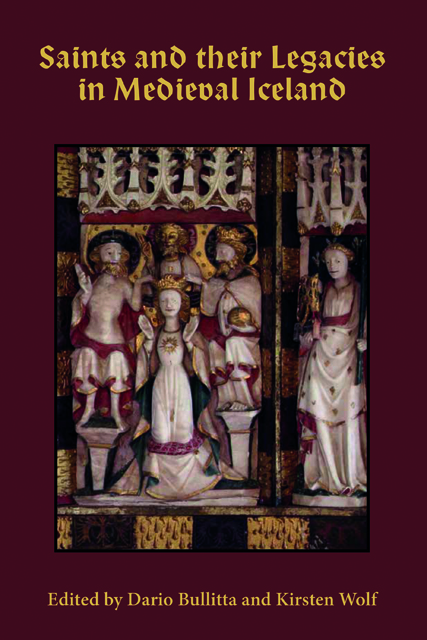Book contents
- Frontmatter
- Contents
- List of Illustrations
- List of Contributors
- Acknowledgments
- List of Abbreviations
- Introduction: The Splendor of the Saints
- Rannsǫkun Heilagra Bóka: The Search for Holy Books
- Heilagir Byskupar: Holy Bishops
- Heilagir Karlar ok Englar: Holy Men and Angels
- Heilagar Meyjar: Holy Maidens
- Bibliography
- Index of Manuscripts
- General Index
- Studies in Old Norse Literature
11 - Katrínarhólar: St Catherine’s Hills, Milk, and Mount Sinai
Published online by Cambridge University Press: 14 January 2023
- Frontmatter
- Contents
- List of Illustrations
- List of Contributors
- Acknowledgments
- List of Abbreviations
- Introduction: The Splendor of the Saints
- Rannsǫkun Heilagra Bóka: The Search for Holy Books
- Heilagir Byskupar: Holy Bishops
- Heilagir Karlar ok Englar: Holy Men and Angels
- Heilagar Meyjar: Holy Maidens
- Bibliography
- Index of Manuscripts
- General Index
- Studies in Old Norse Literature
Summary
Katrínarhóll (‘Catherine’s hill or hillock’) is a rather steep hill or hillock close to the farm of Húsafell (Borgarfjörður) in the western part of Iceland and offers a splendid view. The site draws attention, because it is in the vicinity of Sesseljuvarða (‘Sesselja’s cairn’), which is closer to the farm (see Fig. 11.1). Sesseljuvarða has been associated with St Cecilia, in Icelandic Sesselja, who was a patron saint of the church at Húsafell in the Catholic Middle Ages. Accordingly, Katrínarhóll might also be of medieval origin. There is good evidence of its name in sources dating from the eighteenth century onwards, yet they cannot explain the origin of the name. It is a prominent landmark at a much-traveled road; and therefore, the name is probably quite old.
Sesseljuvarða could originally have been a regular cairn of stones. At present, it is an irregular and huge pile of stones. It is believed that medieval pilgrims on their way from the west to Sesseljuvarða laid stones at the cairn because that is exactly where they saw the church at Húsafell for the first time. Accordingly, it could be seen as a ‘mons gaudii’ (‘a mount of joy’). A similar pile of stones is found in, for example, Cruz de Ferro (on the Montes de León), where pilgrims on their way to Santiago de Compostela added a stone. When they finally arrived at Monte de Gozo (‘The Mount of Joy’), they were able to see Compostela for the first time. Pilgrimage to St Cecilia at Húsafell is well attested in the late twelfth century. This was possibly the beginning of a tradition, pilgrims seeking St Cecilia at Húsafell for the times to come.
Katrínarhóll might take its name after the virgin martyr and princess St Catherine of Alexandria (c. 287‒c. 305). There is a cairn at the top of Katrínarhóll, alas of indiscernable age. Moreover, there was another church at the deserted medieval farm of Reyðarfell, much closer to the Katrínarhóll, which may have been visible at the ‘hóll’ to people arriving from the west. The location of the church at Reyðarfell is known, but when tested that spot could not be seen from Katrínarhóll.
- Type
- Chapter
- Information
- Saints and their Legacies in Medieval Iceland , pp. 279 - 306Publisher: Boydell & BrewerPrint publication year: 2021



